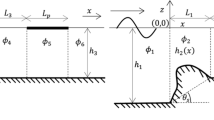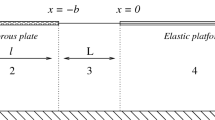Abstract
In the present study, hydroelastic response mitigation of a very large floating circular structure by an annular flexible permeable membrane is studied under the assumption of the linearized theory of water waves and small amplitude structural response. The very large floating structure is modeled based on small amplitude plate theory, while the flexible annular membrane is modeled using the two-dimensional string equation. Darcy’s law is used to model wave past the permeable annular membrane. To keep the structures in position, both the floating structures are assumed to be moored on the circular boundaries. The velocity potentials are expanded in terms of the Fourier–Bessel series in the open water, membrane-, and plate-covered regions. The solution of the physical problem is obtained using the matched eigenfunction expansion method along with the orthogonality of the vertical eigenfunctions in the open water region. On the other hand, orthogonal mode–coupling relation, satisfied by the vertical eigenfunctions in the floating flexible plate-covered region, is used when there is no spacing between the outer and the inner structures. The wave forces exerted on the inner and outer structures, deflection of the plate, and flow distribution around the inner plate are analyzed using numerical computations to understand the hydroelastic response of the inner elastic plate in the presence of the outer porous membrane. The effects of various wave and structural parameters such as wavenumber, porous-effect parameter, tensile force, width of the outer membrane, spring constants associated with the mooring joints, and the spacing between the structures are examined. The study reveals that the porous-effect parameter and the width of the annular membrane play an important role in reducing the wave forces on the inner plate. Moreover, due to the reflection and dissipation of a major part of the wave energy concentrating near the free surface, the inner floating structure experiences negligible wave loads in the case of deep water.


























Similar content being viewed by others
References
Lamas-Pardo M, Iglesias G, Carral L (2015) A review of very large floating structures (VLFS) for coastal and offshore uses. Ocean Eng 109:677–690
Bhattacharya B, Fujikubo M, Hudson DA, Riggs HR, Seto H, Shin H, Shugar TA, Yasuzawa Y, Zong Z (2006) Very large floating structures. In: Proceedings of the16th international ship and offshore structures congress, Southampton, pp 391–442
Kagemoto H (1995) On the comparisons of behaviours in waves of semisubmersible-type and pontoon-type very large floating structures. Ocean Eng Symp 13:231–238
Kashiwagi M (2000) Hydrodynamic interactions among a great number of columns supporting a very large flexible structure. J Fluids Struct 14(7):1013–1034
Ohmatsu S (2005) Overview: Research on wave loading and responses of VLFS. Mar Struct 18(2):149–168
Chong W, Watanabe E, Utsunomiya T (1995) An eigenfunction expansion-matching method for analyzing the wave-induced responses of an elastic floating plate. Appl Ocean Res 17(5):301–310
Sturova IV (1999) Oblique incidence of surface waves on an elastic plate. J Appl Mech Tech Phys 40(4):604–610
Takagi K (1997) Interaction between solitary wave and floating elastic plate. J Waterw Port Coast Ocean Eng 123(2):57–62
Sturova IV (2001) The diffraction of surface waves by an elastic platform floating on shallow water. J Appl Math Mech 65(1):109–117
Kohout AL, Meylan MH (2006) A model for wave scattering in the marginal ice zone based on a two-dimensional floating-elastic-plate solution. Ann Glaciol 44:101–107
Wadhams P, Squire VA, Ewing JA, Pascal RW (1986) The effect of the marginal ice zone on the directional wave spectrum of the ocean. J Phys Oceanogr 16(2):358–376
Meylan MH, Squire VA (1996) Response of a circular ice floe to ocean waves. J Geophys Res Oceans 101(C4):8869–8884
Squire VA (2008) Synergies between VLFS hydroelasticity and sea-ice research. In: The eighteenth international offshore and polar engineering conference. International Society of Offshore and Polar Engineers
Squire VA (2011) Past, present and impendent hydroelastic challenges in the polar and subpolar seas. Philos Trans R Soc Lond A 369(1947):2813–2831
Mondal R, Mandal S, Sahoo T (2014) Surface gravity wave interaction with circular flexible structures. Ocean Eng 88:446–462
Watanabe E, Utsunomiya T, Wang CM, **ang Y (2003) Hydroelastic analysis of pontoon-type circular VLFS. In: The thirteenth international offshore and polar engineering conference. International Society of Offshore and Polar Engineers
Andrianov AI, Hermans AJ (2006) Hydroelastic behavior of a floating ring-shaped plate. J Eng Math 54(1):31–48
Hassan MUL, Meylan MH, Peter MA (2009) Water-wave scattering by submerged elastic plates. Q J Mech Appl Math 62(3):321–344
Takagi K, Shimada K, Ikebuchi T (2000) An anti-motion device for a very large floating structure. Mar Struct 13(4–5):421–436
Karmakar D, Bhattacharjee J, Sahoo T (2010) Oblique flexural gravity-wave scattering due to changes in bottom topography. J Eng Math 66(4):325–341
Ohta H (1999) Effect of attachment of a horizontal/vertical plate on the wave response of a VLFS. In: Proceedings of international workshop on very large floating structures (VLFS’99), vol 1, pp 265–274
Ikoma T, Masuda K, Rheem C-K, Maeda H, Togane M (2009) Hydroelastic motion of aircushion type large floating structures with several aircushions using a three-dimensional theory. In: ASME 2009 28th international conference on ocean, offshore and arctic engineering. American Society of Mechanical Engineers, pp 1331–1338
Norris AN, Vemula C (1995) Scattering of flexural waves on thin plates. J Sound Vib 181(1):115–125
Cho IH, Kim MH (2013) Transmission of oblique incident waves by a submerged horizontal porous plate. Ocean Eng 61:56–65
Molin B, Remy F (2015) Inertia effects in tld sloshing with perforated screens. J Fluids Struct 59:165–177
Meylan MH, Bennetts LG, Peter MA (2017) Water-wave scattering and energy dissipation by a floating porous elastic plate in three dimensions. Wave Motion 70:240–250
Nguyen HP, Dai J, Wang CM, Ang KK, Luong VH (2018) Reducing hydroelastic responses of pontoon-type VLFS using vertical elastic mooring lines. Mar Struct 59:251–270
Singla S, Martha SC, Sahoo T (2018) Mitigation of structural responses of a very large floating structure in the presence of vertical porous barrier. Ocean Eng 165:505–527
Singla S, Sahoo T, Martha SC, Behera H (2019) Effect of a floating permeable plate on the hydroelastic response of a very large floating structure. J Eng Math 116:49–72
Manam SR, Bhattacharjee J, Sahoo T (2005) Expansion formulae in wave structure interaction problems. Proc R Soc A 462(2065):263–287
Koley S, Mondal R, Sahoo T (2018) Fredholm integral equation technique for hydroelastic analysis of a floating flexible porous plate. Eur J Mech B 67:291–305
Karmakar D, Soares CG (2012) Scattering of gravity waves by a moored finite floating elastic plate. Appl Ocean Res 34:135–149
Koley S, Sahoo T (2017) Oblique wave scattering by horizontal floating flexible porous membrane. Meccanica 52(1–2):125–138
Karmakar D, Sahoo T (2008) Gravity wave interaction with floating membrane due to abrupt change in water depth. Ocean Eng 35(7):598–615
Mandal S, Sahoo T (2016) Gravity wave interaction with a flexible circular cage system. Appl Ocean Res 58:37–48
Garrett CJR (1971) Wave forces on a circular dock. J Fluid Mech 46(1):129–139
Pete MA, Meylan MH, Chung H (2004) Wave scattering by a circular elastic plate in water of finite depth: a closed form solution. Int J Offshore Polar Eng 14(2):81–85
Sahoo T, Lee MM, Chwang AT (2000) Trap** and generation of waves by vertical porous structures. J Eng Mech 126(10):1074–1082
Schulkes RMSM, Hosking RJ, Sneyd AD (1987) Waves due to a steadily moving source on a floating ice plate. Part 2. J Fluid Mech 180:297–318
Acknowledgements
HB gratefully acknowledges the financial support from SERB, Department of Science and Technology, Government of India through “CRG”project, Award No. CRG/2018/004521. TS acknowledges the financial support received from the Department of Science and Technology, Government of India through Award No. DST/CCP/CoE/79/2017(G).
Author information
Authors and Affiliations
Corresponding author
Additional information
Publisher's Note
Springer Nature remains neutral with regard to jurisdictional claims in published maps and institutional affiliations.
Rights and permissions
About this article
Cite this article
Selvan, S.A., Behera, H. & Sahoo, T. Reduction of hydroelastic response of a flexible floating structure by an annular flexible permeable membrane. J Eng Math 118, 73–99 (2019). https://doi.org/10.1007/s10665-019-10015-9
Received:
Accepted:
Published:
Issue Date:
DOI: https://doi.org/10.1007/s10665-019-10015-9




